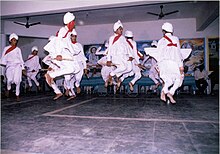 Mer Rās or Maniyaro (a type of dandiya dance) | |
| Total population | |
|---|---|
| 250,000 (1980) | |
| Regions with significant populations | |
| Gujarat, India: Porbandar, Junagadh, Dwarka, Jamnagar | |
| Languages | |
| Gujarati | |
| Religion | |
| Hinduism | |
| Related ethnic groups | |
| Gujarati people |
Mer, Maher or Mehar (Gujarati: ISO 15919: Mēr, Mahēr, Mēhar) is a caste from the Saurashtra region of Gujarat in India.[1][2][3] They are largely based in the Porbandar district, comprising the low-lying, wetland Ghēḍ and highland Barḍā areas, and they speak a dialect of the Gujarati language.[4][5][6] The Mers of the Ghēḍ and Barḍā form two groups of the jāti and together they are the main cultivators in the Porbandar District.[7] Historically, the men served the Porbandar State as a feudal militia, led by Mer leaders.[8][9] In the 1881 Gazette of the Bombay Presidency, the Mers were recorded numbering at 23,850.[10] The 1951 Indian Census recorded 50,000 Mers.[11] As of 1980 there were estimated to be around 250,000 Mers.[12]
- ^ Trivedi 1961, pp. 1, 14, 40.
- ^ Diskalkar, D B (1941). "Inscriptions of Kathiawad". New Indian Antiquary. 1: 580 – via Archiv.org.
The Mahuva inscription of v.s. 1272 speaks of a Mehara king ruling at Timbanaka. He was probably a successor of the Mehar king Jagaraal, a feudatory of the Caulukya sovereign Bhima II mentioned in the copperplate grant of v.s. 1264 found at Timana and published in the Indian Antiquary Vol. XI p. 337. Another Meher family is mentioned in the Hataspi inscription of v.s. 1386. In modem times the Mehers are found chiefly in the Porbunder State and not in the part of Kathiawad where the abovementioned inscriptions were found.
- ^ Fischer, Eberhard; Shah, Haku (1970). Rural craftsmen and their work: Equipment and techniques in the Mer village of Ratadi, in Saurashtra India. Paldi, Ahmedabad: National Institute of Design. p. 118.
- ^ Franco, Fernando; Macwan, Jyotsna; Ramanathan, Suguna (2004). Journeys to Freedom: Dalit Narratives. Popular Prakashan. pp. 242–. ISBN 978-81-85604-65-7. Retrieved 6 April 2013.
- ^ Trivedi 1986, p. viii.
- ^ Trivedi 1961, pp. 1–3.
- ^ Trivedi 1961, pp. 100–103.
- ^ Maddock 1993, p. 104.
- ^ Campbell 1881, p. 138.
- ^ Campbell 1881, p. 139.
- ^ Trivedi 1999, p. 1.
- ^ Trivedi 1999, p. 9.
© MMXXIII Rich X Search. We shall prevail. All rights reserved. Rich X Search
